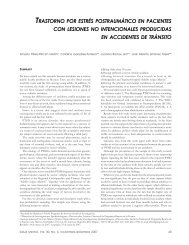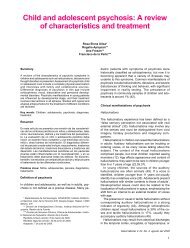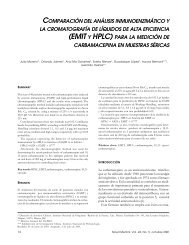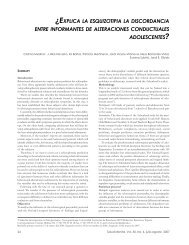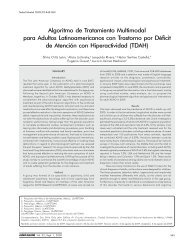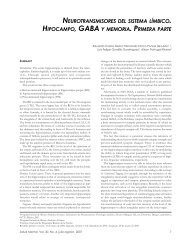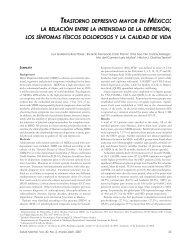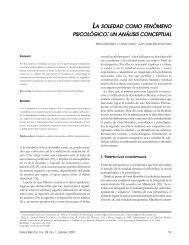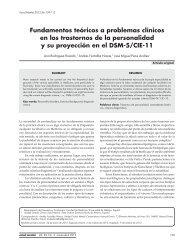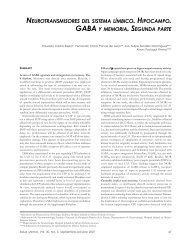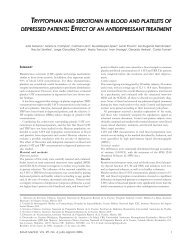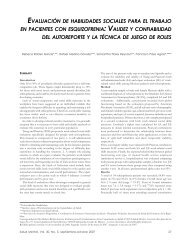Electroencefalograma y potenciales relacionados con eventos en el
Electroencefalograma y potenciales relacionados con eventos en el
Electroencefalograma y potenciales relacionados con eventos en el
Create successful ePaper yourself
Turn your PDF publications into a flip-book with our unique Google optimized e-Paper software.
Garc<strong>el</strong>l y Rueda Medina<br />
and larger amplitudes for the P3b and N200 compon<strong>en</strong>ts, suggesting<br />
hyperarousal of the cortex and overfocused att<strong>en</strong>tion. However, there<br />
have also be<strong>en</strong> described shorter amplitudes and larger lat<strong>en</strong>cies<br />
for the P300 compon<strong>en</strong>t in the frontal regions, which have be<strong>en</strong> r<strong>el</strong>ated<br />
to an impairm<strong>en</strong>t of working memory or att<strong>en</strong>tion. Some authors<br />
have observed an inverse corr<strong>el</strong>ation betwe<strong>en</strong> the N200 amplitude<br />
and the severity of the symptoms as w<strong>el</strong>l as a positive corr<strong>el</strong>ation<br />
betwe<strong>en</strong> this variable and the response to treatm<strong>en</strong>t with s<strong>el</strong>ective<br />
serotonine reuptake inhibitors, but others have pointed out that<br />
pati<strong>en</strong>ts that respond to treatm<strong>en</strong>t have a lower N200 amplitude, a<br />
larger P300 amplitude and a N200 and P300 shorter lat<strong>en</strong>cies.<br />
As for the possible association betwe<strong>en</strong> the ERPs and the<br />
disease’s evolution time, there has be<strong>en</strong> a positive corr<strong>el</strong>ation betwe<strong>en</strong><br />
the N200 amplitude and the chronicity of the disorder. It has also<br />
be<strong>en</strong> found that the amplitude of the P300 compon<strong>en</strong>t is positiv<strong>el</strong>y<br />
associated with the severity of symptoms assessed by the Yale-Brown<br />
obsessive compulsive scale.<br />
Finally, it can be <strong>con</strong>sidered that, from a clinical point of view,<br />
pati<strong>en</strong>ts with OCD have the fe<strong>el</strong>ing that «something is not right» or «of<br />
having committed an omission» wh<strong>en</strong> it has not be<strong>en</strong> committed, and<br />
«get caught» on excessive verification responses wh<strong>en</strong> an error mistake<br />
has happ<strong>en</strong>ed. That ph<strong>en</strong>om<strong>en</strong>ological <strong>con</strong>sideration has be<strong>en</strong><br />
associated to an alteration of the action monitoring process, which<br />
repres<strong>en</strong>ts one of the executive functions mediated by the frontal regions,<br />
particularly the anterior cingulate cortex, which may be «hyperactive»<br />
in OCD pati<strong>en</strong>ts wh<strong>en</strong> they have the fe<strong>el</strong>ing of having made a mistake.<br />
The action monitoring process has be<strong>en</strong> evaluated in pati<strong>en</strong>ts with<br />
OCD through an ERP compon<strong>en</strong>t called «Error-r<strong>el</strong>ated Negativity» (ERN).<br />
The ERN is a negative wave around the 50-150 ms, which appears<br />
after the subject committed an error or thinks it has be<strong>en</strong> done. In an<br />
ERN study it was found greater ERN amplitudes in the frontal regions<br />
in subjects with high obsessivity rates compared to subjects with low<br />
obsessivity ones, which is <strong>con</strong>sist<strong>en</strong>t with the hyperactivity hypothesis<br />
of the fronto-temporal system proposed for this disorder and is<br />
according to the theory that pati<strong>en</strong>ts with OCD show an increase of the<br />
monitoring function wh<strong>en</strong> a mistake has be<strong>en</strong> done.<br />
However, there are authors who have not found differ<strong>en</strong>ces in<br />
the NRE betwe<strong>en</strong> healthy subjects and pati<strong>en</strong>ts with OCD under<br />
pharmacological treatm<strong>en</strong>t, but they have observed a significant<br />
negative association betwe<strong>en</strong> the ERN amplitude and the severity of<br />
the disorder. Hajcak et al. 2008, noticed an amplitude ERN increase<br />
in a group of subjects with pediatric OCD compared with the <strong>con</strong>trol<br />
group, which is <strong>con</strong>sist<strong>en</strong>t with ERN adult studies. In addition, since<br />
the ERN was not associated with the symptom severity or the response<br />
to treatm<strong>en</strong>t with cognitive behavioral therapy, that is why this<br />
alteration of the ERN could be a trait-like marker. Based on the<br />
foregoing, these researchers suggested that the increase in the<br />
amplitude of the NRE could be <strong>con</strong>sidered as an <strong>en</strong>doph<strong>en</strong>otype.<br />
The EEG and ERPs can do an important <strong>con</strong>tribution, in<br />
<strong>con</strong>junction with clinical and imaging studies, to the id<strong>en</strong>tification of<br />
the structures and circuits involved in the pathophysiology of OCD.<br />
In addition, there are several evid<strong>en</strong>ces to support the utility of these<br />
<strong>el</strong>ectrophysiological techniques as complem<strong>en</strong>tary studies in the<br />
clinical evaluation and treatm<strong>en</strong>t of pati<strong>en</strong>ts with OCD.<br />
Key words: Obsessive-compulsive disorder, <strong>el</strong>ectro<strong>en</strong>cephalogram,<br />
ev<strong>en</strong>t-r<strong>el</strong>ated pot<strong>en</strong>tials, P300, frequ<strong>en</strong>cy analysis.<br />
RESUMEN<br />
El Trastorno Obsesivo Compulsivo (TOC) es un trastorno psiquiátrico<br />
crónico, clínicam<strong>en</strong>te heterogéneo, multidim<strong>en</strong>sional, caracterizado<br />
por la pres<strong>en</strong>cia de obsesiones y compulsiones, <strong>en</strong> <strong>el</strong> cual la<br />
ansiedad es un compon<strong>en</strong>te fundam<strong>en</strong>tal d<strong>el</strong> cuadro clínico. Los<br />
estudios de imág<strong>en</strong>es ti<strong>en</strong><strong>en</strong> una gran resolución espacial que permite<br />
la id<strong>en</strong>tificación de las alteraciones pres<strong>en</strong>tes <strong>en</strong> esta <strong>en</strong>tidad<br />
pero ti<strong>en</strong><strong>en</strong> m<strong>en</strong>or resolución temporal y son de mayor costo que los<br />
estudios <strong>el</strong>ectrofisiológicos. Entre las técnicas <strong>el</strong>ectrofisiológicas más<br />
utilizadas para investigar <strong>el</strong> TOC se <strong>en</strong>cu<strong>en</strong>tran <strong>el</strong> <strong>el</strong>ectro<strong>en</strong>cefalograma<br />
(EEG) y los <strong>pot<strong>en</strong>ciales</strong> <strong>r<strong>el</strong>acionados</strong> <strong>con</strong> <strong>ev<strong>en</strong>tos</strong> (PREs). El<br />
EEG es <strong>el</strong> registro de la actividad <strong>el</strong>éctrica cerebral, es decir, de las<br />
difer<strong>en</strong>cias de voltaje <strong>en</strong>tre dos <strong>el</strong>ectrodos situados sobre <strong>el</strong> cuero<br />
cab<strong>el</strong>ludo, <strong>en</strong> función d<strong>el</strong> tiempo. Los PREs son las fluctuaciones de<br />
voltaje que están asociadas temporalm<strong>en</strong>te a la pres<strong>en</strong>cia de un<br />
ev<strong>en</strong>to físico o m<strong>en</strong>tal.<br />
El tipo de EEG más <strong>con</strong>ocido es aquél que se analiza por<br />
inspección visual (EEG tradicional: EEG-T) y que se describe mediante<br />
la pres<strong>en</strong>cia y distribución topográfica de cuatro tipos de actividades<br />
<strong>el</strong>ectro<strong>en</strong>cefalográficas: d<strong>el</strong>ta (δ), theta (θ), alfa (α) y beta (β). Las<br />
bandas δ y θ se id<strong>en</strong>tifican como actividades l<strong>en</strong>tas mi<strong>en</strong>tras que las<br />
bandas α y β se <strong>con</strong>oc<strong>en</strong> como actividades rápidas. En <strong>el</strong> TOC se ha<br />
referido la actividad l<strong>en</strong>ta como la anormalidad más común <strong>en</strong> <strong>el</strong><br />
EEG-T, especialm<strong>en</strong>te la actividad de tipo θ, aunque también se han<br />
descrito EEGs normales. Por otra parte, las medidas espectrales de<br />
banda ancha (MEBAs) han comprobado este exceso de actividad<br />
l<strong>en</strong>ta además de anormalidades <strong>en</strong> las bandas rápidas,<br />
particularm<strong>en</strong>te <strong>en</strong> la α.<br />
Entre las MEBAs más utilizadas se <strong>en</strong>cu<strong>en</strong>tran la pot<strong>en</strong>cia<br />
absoluta y la pot<strong>en</strong>cia r<strong>el</strong>ativa. Se ha demostrado, tanto <strong>con</strong> las<br />
MEBAs como <strong>con</strong> <strong>el</strong> análisis de g<strong>en</strong>eradores d<strong>el</strong> EEG, que aqu<strong>el</strong>los<br />
paci<strong>en</strong>tes que ti<strong>en</strong><strong>en</strong> un exceso de α <strong>en</strong> regiones anteriores y medias<br />
respond<strong>en</strong> mejor a los inhibidores de la recaptura de serotonina, lo<br />
cual es de gran utilidad clínica.<br />
Los PREs se divid<strong>en</strong> <strong>en</strong> dos tipos: exóg<strong>en</strong>os y <strong>en</strong>dóg<strong>en</strong>os. En<br />
este trabajo se hará refer<strong>en</strong>cia a los <strong>en</strong>dóg<strong>en</strong>os o cognitivos. Entre<br />
los compon<strong>en</strong>tes de los PREs cognitivos más característicos están <strong>el</strong><br />
N200 y <strong>el</strong> P300. En los paci<strong>en</strong>tes <strong>con</strong> TOC se han descrito amplitudes<br />
mayores y lat<strong>en</strong>cias más cortas <strong>en</strong> los compon<strong>en</strong>tes P3b y N200, lo<br />
cual se ha atribuido a hiperalertami<strong>en</strong>to cortical y sobrefocalización<br />
de la at<strong>en</strong>ción. También se han observado corr<strong>el</strong>aciones positivas<br />
<strong>en</strong>tre la amplitud d<strong>el</strong> compon<strong>en</strong>te N200 y la cronicidad d<strong>el</strong> trastorno<br />
y <strong>en</strong>tre la amplitud d<strong>el</strong> compon<strong>en</strong>te P300 y la severidad de la<br />
sintomatología d<strong>el</strong> TOC. Los paci<strong>en</strong>tes <strong>con</strong> este trastorno ti<strong>en</strong><strong>en</strong> la<br />
s<strong>en</strong>sación de que «algo no está bi<strong>en</strong>» y se «<strong>en</strong>ganchan» <strong>en</strong> respuestas<br />
de verificación excesiva. Esto se ha asociado <strong>con</strong> una alteración <strong>en</strong> <strong>el</strong><br />
proceso de monitorización de la acción, que repres<strong>en</strong>ta una de las<br />
funciones ejecutivas a cargo de las regiones frontales, particularm<strong>en</strong>te<br />
d<strong>el</strong> cíngulo anterior, <strong>el</strong> cual posiblem<strong>en</strong>te se «hiperactive» <strong>en</strong> los<br />
paci<strong>en</strong>tes <strong>con</strong> TOC cuando ti<strong>en</strong><strong>en</strong> la s<strong>en</strong>sación de haber cometido un<br />
error. La «negatividad r<strong>el</strong>acionada al error» (NRE) es una onda negativa,<br />
alrededor de los 50-150 ms, posterior a que <strong>el</strong> sujeto cometió un<br />
error o cuando está seguro de haberlo cometido.<br />
Se ha <strong>en</strong><strong>con</strong>trado que los paci<strong>en</strong>tes <strong>con</strong> TOC (niños y adultos)<br />
muestran un increm<strong>en</strong>to de la negatividad de este compon<strong>en</strong>te <strong>en</strong><br />
comparación a sujetos <strong>con</strong>troles y se ha propuesto que pudiera<br />
<strong>con</strong>siderarse como un marcador biológico d<strong>el</strong> TOC.<br />
El EEG y los PREs pued<strong>en</strong> <strong>con</strong>tribuir de manera importante,<br />
junto <strong>con</strong> los estudios clínicos e imag<strong>en</strong>ológicos, a la id<strong>en</strong>tificación<br />
de las estructuras y circuitos involucrados <strong>en</strong> la fisiopatología d<strong>el</strong><br />
TOC. Además, hay evid<strong>en</strong>cias que apoyan la utilidad de estas técnicas<br />
<strong>el</strong>ectrofisiológicas como estudios complem<strong>en</strong>tarios <strong>en</strong> la evaluación<br />
clínica y terapéutica de los paci<strong>en</strong>tes <strong>con</strong> TOC.<br />
Palabras clave: Trastorno obsesivo compulsivo, <strong>el</strong>ectro<strong>en</strong>cefalograma,<br />
<strong>pot<strong>en</strong>ciales</strong> <strong>r<strong>el</strong>acionados</strong> <strong>con</strong> <strong>ev<strong>en</strong>tos</strong>, P300, análisis de frecu<strong>en</strong>cia.<br />
174 Vol. 32, No. 2, marzo-abril 2009



